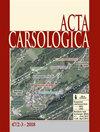Fate of Contaminants of Emerging Concern in a Sinkhole Lake, Florida, USA
IF 1.1
4区 地球科学
Q4 GEOSCIENCES, MULTIDISCIPLINARY
引用次数: 2
Abstract
Highly karstified carbonate platforms such as Florida are characterized by rapid infiltration rates, highly permeable bedrock and the direct connection to the below aquifer through the high density of sinkholes. This combination of physical features makes the groundwater and aquifers highly vulnerable to contamination from synthetic chemicals commonly referred to as contaminants of emerging concern (CECs). The use of septic tanks, otherwise referred to as onsite water treatment systems (OWTS), promotes the introduction of CECs into the environment. In order to study the impacts of CECs from OWTS on a karst landscape, water, sediment, and vegetation samples were collected in a sinkhole lake surrounded by residential housing using this waste disposal method. The main question of this research project is what is the fate of CECs from OWTSs effluent within the catchment of a sinkhole lake? Liquid chromatograph mass spectrometry was used to analyze the samples for the presence of CECs. It was found that the relative quantity of CECs in the individual constituents is dependent upon 1) the hydrophobicity and polarity of the individual compound, 2) the specific sampling site, 3) the topography gradient, and 4) for vegetation, the connectedness of the sample type to the sediment. Hydrogeological studies have found that the sinkholes of the area are all connected to the below aquifer. Consequently, these CECs pose a risk of the contamination of the groundwater. This study is a temporal snapshot, that being the dry season of Florida which is most likely the time of lowest CEC contamination. It is imperative that sampling extend into the wet season when flushing of CECs from the OWTS may increase their concentrations in both the lake but also the aquifers especially since residents use well water as their source of potable water. While this study is based in Florida, we strongly suspect that our findings and recommendations are applicable more generally as OWTS are used throughout the many karst regions of the world.美国佛罗里达州沉孔湖中新出现的污染物的命运
佛罗里达等高度岩溶的碳酸盐岩平台具有快速渗透率、高渗透性基岩以及通过高密度的天坑与地下含水层直接连接的特点。这种物理特征的结合使地下水和含水层极易受到合成化学物质的污染,通常被称为新出现的污染物(CECs)。化粪池的使用,也被称为现场水处理系统(OWTS),促进了CEC进入环境。为了研究OWTS的CEC对岩溶景观的影响,使用这种废物处理方法在住宅周围的天坑湖中收集了水、沉积物和植被样本。这个研究项目的主要问题是,在天坑湖的集水区内,来自OWTS废水的CEC的命运是什么?液相色谱-质谱法用于分析样品中CECs的存在。研究发现,CECs在单个成分中的相对数量取决于1)单个化合物的疏水性和极性,2)特定的采样点,3)地形梯度,以及4)对于植被,样品类型与沉积物的连通性。水文地质研究发现,该地区的天坑都与下面的含水层相连。因此,这些CEC存在地下水污染的风险。这项研究是一个时间快照,佛罗里达州的旱季很可能是CEC污染最低的时候。采样必须延伸到雨季,因为从OWTS冲洗CEC可能会增加其在湖泊和含水层中的浓度,特别是因为居民使用井水作为饮用水源。虽然这项研究是在佛罗里达州进行的,但我们强烈怀疑,由于OWTS在世界上许多岩溶地区都有使用,我们的发现和建议更普遍地适用。
本文章由计算机程序翻译,如有差异,请以英文原文为准。
求助全文
约1分钟内获得全文
求助全文
来源期刊

Acta Carsologica
地学-地球科学综合
CiteScore
1.50
自引率
14.30%
发文量
0
审稿时长
>12 weeks
期刊介绍:
Karst areas occupy 10-20 % of ice-free land. Dissolution of rock by natural waters has given rise to specific landscape and underground. Karst surface features and caves have attracted man''s curiosity since the dawn of humanity and have been a focus to scientific studies since more than half of millennia.
Acta Carsologica publishes original research papers and reviews, letters, essays and reports covering topics related to specific of karst areas. These comprise, but are not limited to karst geology, hydrology, and geomorphology, speleology, hydrogeology, biospeleology and history of karst science.
 求助内容:
求助内容: 应助结果提醒方式:
应助结果提醒方式:


